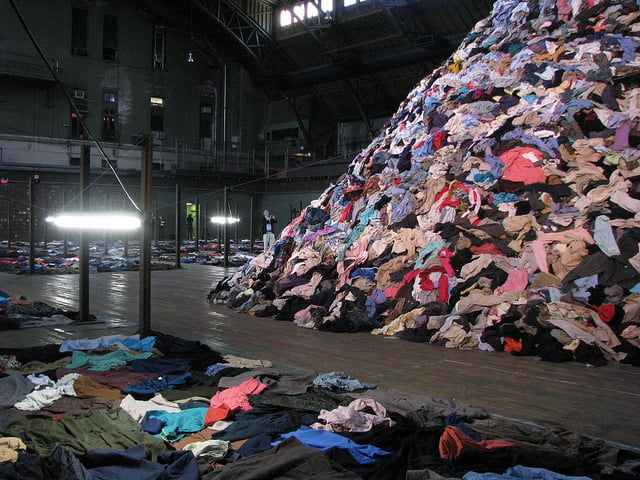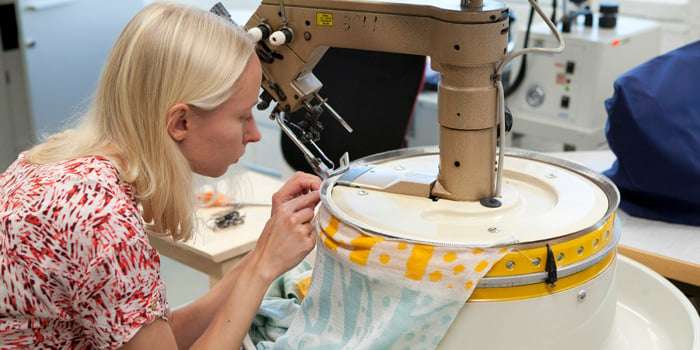New Clothing Recycling Technology Aims to Reduce Clothing Waste
 Photo: Christian Boltanski via Flickr
Photo: Christian Boltanski via Flickr
The apparel industry is the second largest polluter in the world—accounting for 10% of global carbon emissions—the only industry producing more pollution is that of oil.

The overall impacts of the fast fashion industry are quite grim. In this relatively new, but, popular trend, clothing companies introduce new styles at a much higher frequency than what had been considered a more traditional pace.
This trend attracts consumers because the clothes are much cheaper (due to where and how they are produced). Since the cost of clothing is so cheap, people are changing outfits more often and simply discarding what they aren't wearing, since they can afford to do so.
It's estimated that the average American throws away 82 pounds of clothing each year, with only 15% of the vast quantity of clothing waste being reused or recycled.
But when you recycle your clothes, the fabric doesn't become a new T-shirt or pair of pants (similar to a glass bottle being remanufactured into a new bottle). Currently what happens is that clothing is simply reused as is or repurposed into something else, for example, into wiping rags or insulation.
There have been attempts to take apart and respin used clothing into new cloth, but the attempts have largely been unsuccessful. This is because by the time the fabric is reprocessed, it's nowhere near as strong as the original.
But, this has all changed with the help of some scientists working to develop new clothing recycling techniques.
New Recycling Techniques
A research team in Finland recently developed a recycling technique that recycles cotton-polyester clothes into lyocell-like fibers. This technique will allow clothes to be recycled time and time again, and divert millions of textiles from ending up in the landfill each year.
Herbert Sixta of the Aalto University championed the research for new textile recycling techniques. About five years ago, Sixta's team found an ionic liquid (liquid salt) that can dissolve cellulose from wood pulp, producing a material that could be spun into fibers.
 Photo: Aalto University School of Chemical Engineering
Photo: Aalto University School of Chemical Engineering
For example, when they applied this liquid to a poly-cotton blend, it dissolved the cotton, but not the polyester. Once the cotton dissolved, the polyester just needed to be filtered out. The dissolved cellulose could then be used to make stronger fibers.
Later testing showed that these fibers are actually stronger than commercially available viscose, which can be used to produce cotton; and the fibers felt similar to lyocell or Tencel, which is a fiber favored by many eco-conscious designers.
The researchers are still trying to determine whether the remaining polyester can be re-spun for use in new fabric and studying the possibility of reusing dyes from recycled clothes. If so, this would be an even bigger development in the way we recycle textiles.
The project was presented at the National Meeting and Exposition of the American Chemical Society, which took place at the beginning of April.
Another technique, similar to the one above, is being developed by a Swedish textile recycling development firm, re:newcell. Re:newcell announced last year that they had started construction on a demonstration facility to continue developing new ways to recycle cotton.
The company said at the time that it had developed a method of taking the waste from the textile industry and producing new pulp, which can be used to manufacture textile materials. These materials can then be transformed into new high quality textiles.
We Are Not There Yet
While neither of these methods is ready for commercial use just yet, these developments highlight the importance and urgency in finding solutions to make the fashion industry more environmentally friendly. In the meantime, remember there are always little things that you can do to help!

1. Reduce: Reduce the amount of clothes you buy. If you are really in need of new clothes, look for quality. These clothes will last longer and prevent you from having to constantly replace items in your closet.
2. Reuse: Shopping at secondhand clothing shops is always a great way to save textiles from ending up in the landfill. You can find some really great things and save money, too!
3. Recycle: When it's time to get rid of those unwanted or unused clothes, always donate them, whether it is with Planet Aid or another textile reuse and recycling organization. You can help be a part of the solution just by not sending your clothes to the landfill. To find a bin nearest you, click here.
